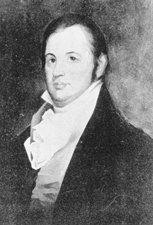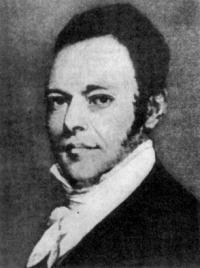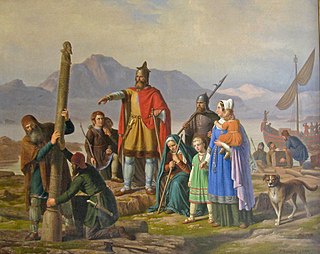
John Breckinridge was a lawyer and politician from the U.S. state of Virginia. He served in the state legislatures of Virginia and Kentucky before being elected to the U.S. Senate and appointed United States Attorney General during the second term of President Thomas Jefferson. He is the progenitor of Kentucky's Breckinridge political family and the namesake of Breckinridge County, Kentucky.

John Pope was a United States Senator from Kentucky, a member of the United States House of Representatives from Kentucky, Secretary of State of Kentucky, and the third Governor of Arkansas Territory.

James Brown was a Virginia-born American lawyer, planter and politician who served as a Secretary of State for the new state of Kentucky, and later as U.S. Senator from Louisiana, and Minister to France (1823-1829) before his retirement and death in Philadelphia.

The Filson Historical Society is a historical society located in the Old Louisville neighborhood of Louisville, Kentucky. The organization was founded in 1884 and named after early Kentucky explorer John Filson, who wrote The Discovery, Settlement, and Present State of Kentucke, which included one of the first maps of the state. The Filson's extensive collections focus on Kentucky, the Upper South, and the Ohio River Valley. Its research facilities include a manuscript collection as well as a library that includes rare books, periodicals, maps, and other published materials. The Filson also maintains a small museum. One distinctive possession of the museum is a section of American beech tree trunk, with the carved legend "D. Boon kilt a bar [killed a bear] 1803."

The history of Louisville, Kentucky spans a bit over two centuries since the latter part of the 18th century. Prior to arrival of Europeans, the region was depopulated from the Beaver Wars of the 17th century, and no permanent Native American settlements existed in the area. It was used as hunting grounds by northern Shawnee and southern Cherokee. The area's geography and location on the Ohio River attracted people from the earliest times. The city is located at the Falls of the Ohio River, then a part of Kentucky County, Virginia. The rapids created a barrier to river travel, and settlements grew up at this portage point. The earliest European settlements were during the latter stages of the American Revolutionary War by Virginian soldiers under George Rogers Clark, first at Corn Island in 1778, then Fort-on-Shore and Fort Nelson on the mainland. The town was chartered in 1780 and named Louisville in honor of King Louis XVI of France. That year it received an influx of 300 settlers.

Basil Wilson Duke was a Confederate general officer during the American Civil War. His most noted service in the war was as second-in-command for his brother-in-law John Hunt Morgan; Duke would later write a popular account of Morgan's most famous raid: 1863's Morgan's Raid. He took over Morgan's command after Morgan was shot by Union soldiers in 1864. At the end of the war, Duke was among Confederate President Jefferson Davis's bodyguards after his flight from Richmond, Virginia, through the Carolinas.

Joseph Rogers Underwood was a lawyer, judge, United States Representative and Senator from Kentucky.

John Filson was an American author, historian of Kentucky, pioneer, surveyor and one of the founders of Cincinnati, Ohio.
Fincastle County, Virginia, was created in 1772 from Botetourt County, the boundaries of which extended all the way to the Mississippi River. Fincastle County was abolished in 1776, and divided into three new counties—Montgomery County, Washington County, and Kentucky County —by action of the Virginia General Assembly.

The Sycamore Shoals of the Watauga River, usually shortened to Sycamore Shoals, is a rocky stretch of river rapids along the Watauga River in Elizabethton, Tennessee. Archeological excavations have found Native Americans lived near the shoals since prehistoric times, and Cherokees gathered there. As Europeans began settling the Trans-Appalachian frontier, the shoals proved strategic militarily, as well as shaped the economies of Tennessee and Kentucky. Today, the shoals are protected as a National Historic Landmark and are maintained as part of Sycamore Shoals State Historic Park.

A longhunter was an 18th-century explorer and hunter who made expeditions into the American frontier wilderness for as much as six months at a time. Historian Emory Hamilton asserts that "The Long Hunter was peculiar to Southwest Virginia only, and nowhere else on any frontier did such hunts ever originate" although the term has been used loosely to describe any unofficial American explorer of the period. Most long hunts started in the Holston River Valley near Chilhowie, Virginia. The hunters came from there and the adjacent valley of the Clinch River, where they were land owners or residents. The parties of two or three men usually started their hunts in October and ended toward the end of March or early in April.

Robert Breckinridge McAfee was a Kentucky diplomat, historian and politician who was the seventh Lieutenant Governor of Kentucky serving from 1824 to 1828.

The history of slavery in Kentucky dates from the earliest permanent European settlements in the state, until the end of the Civil War. Kentucky was classified as the Upper South or a Border state, and enslaved African Americans represented up to 25% of the population before the Civil War, concentrated in the cities of Louisville and Lexington, both in the fertile Bluegrass Region, a center of tobacco plantations and horse farms.

William Maxwell was the first engraver to publish a newspaper in Cincinnati, Ohio. The paper was called the Centinel of the Northwest Territory, and the first issue was published on Saturday, November 9, 1793. The motto of the paper was "Open to all parties–but influenced by none". He used a portable wood printing press, which he took with him to Lexington, Kentucky and set up a business. In 1793 he left for Cincinnati and began his weekly newspaper, which consisted of four pages and had a limited circulation. The printing press he used was much like the one invented by Johann Gutenberg. In 1796 he printed Laws of the Territory of the United States Northwest of the Ohio in Cincinnati, a two-hundred and twenty-five page book with one-thousand issues printed. Subsequently known as "Maxwell's Code", this was the first book printed in the Northwest Territory.

James John Floyd was an early settler of St. Matthews, Kentucky and helped lay out Louisville. In Kentucky he served as a Colonel of the Kentucky Militia in which he participated in raids with George Rogers Clark and later became one of the first judges of Kentucky.

Events from the year 1792 in the United States.
David Rice, called "Father" David Rice and referred to by his contemporaries as the "Apostle to Kentucky," was a renowned antislavery Presbyterian minister during the antebellum era in the United States.

Reuben Thomas Durrett was a lawyer, jurist, linguist, poet, editor, journalist, history writer, and Kentucky bibliographer. He was a founder of the Louisville Free Public Library.

Benjamin Winslow Dudley (1785-1870) was an American surgeon and academic in Kentucky, United States. Trained at the University of Pennsylvania, in London, and in Paris, he performed hundreds of lithotomy, trephinations and treated aneurysms. In his lectures and writing, he stressed the importance of preparation and cleanliness. He served as a Professor of Medicine at Transylvania University from 1817 to 1850, where he taught many future physicians who treated members of the Confederate States Army.


























